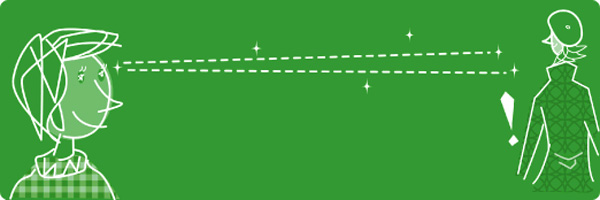- トップページ
- Fantastic Voyagers
- The power of the gaze

The power of the gaze
Can “the sense of being stared at” be scientifically verified?
“His eyes burned holes right through me.” “I felt her stare so powerfully that it hurt.” Literature is full of such descriptions of the “power of the gaze.” But is there a way of confirming whether such a power really exists?
On a street corner or outside of the station you somehow feel that “someone’s staring at you,” and when you turn around, there’s an old friend with a broad grin on his face looking at you. Or you see somebody you know walking ahead of you and as you keep staring and thinking that “she doesn’t seem to notice me,” she suddenly turns around and asks you “were you looking at me?” We all seem to have experiences like that.
Some will say that it’s “pure coincidence,” of course. But since almost everybody has experienced this “feeling of being stared at,” perhaps it shouldn’t be so lightly dismissed.
One who takes this phenomenon seriously is Rupert Sheldrake, and in his book Seven Experiments That Could Change the World, he proposes a simple experiment to verify the “sense of being stared at”:
・The experiment is performed by groups of two people, a test subject (the one to be stared at), who sits with his or her back to the experimenter (the “starer”).
・Each test is performed for 20 seconds. The experimenter flips a coin to decide whether to stare or not. When not staring, he/she should look away and think about something else.
・As the start signal is given, the test subject has to guess whether he/she is being stared at.
・After 20 seconds, the test subject communicates his/her answer to the experimenter.
・The test is repeated a number of times and the results recorded.
Now, this is indeed very easy to try. Apparently, the test needs to be performed at least 10 times to be significant. In one trial done at a junior high school in California, 24 students participated in a total of 480 tests. Their overall accuracy rate was 55.2%. This is far too high to be dismissed as mere chance.
When doing experiments of this type, there will invariably be some people with a much higher accuracy than the others. Perhaps they are the same people who are often said to have “good instincts” or be “especially sensitive” in their daily lives. Conversely, the ones with low accuracies may well be those who are considered “thick.”
Asking those with “good instincts” exactly how they determine that they are being stared should lead to even more profound research. Does this ability function through windows as well? Or from a different room?
Perhaps “thick” people too can improve their performance through repeated tests. Even those who insist that it’s “just a coincidence” might be surprised at their own results if they try this experiment.
